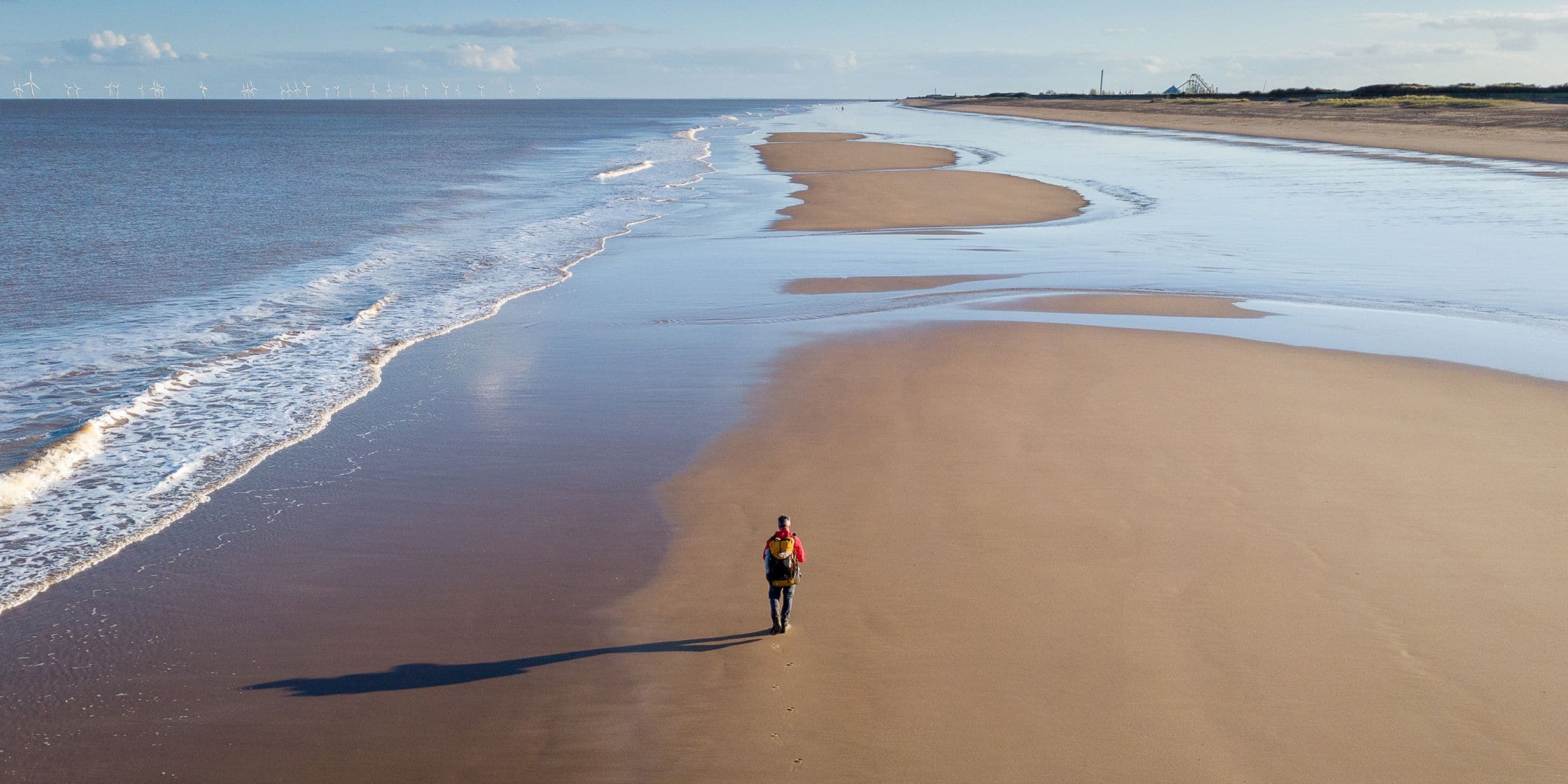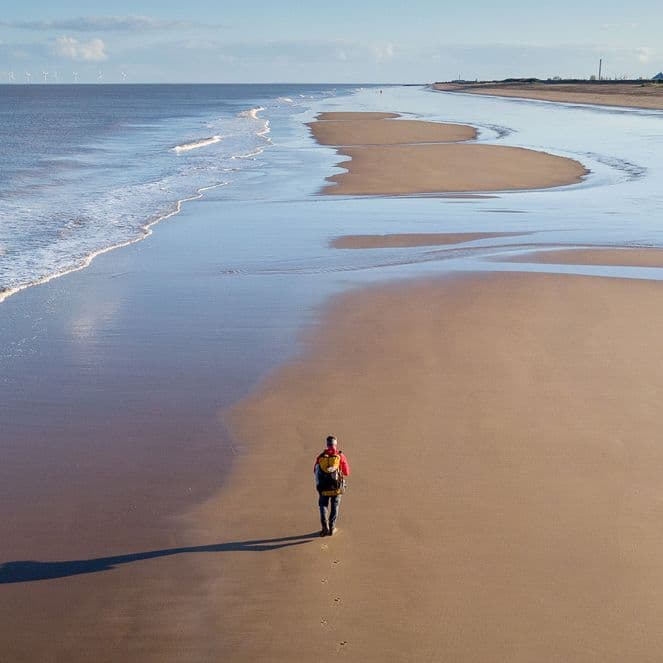Lifestyle
Memoir of the Month: The Perimeter by Quintin Lake
Photographer Quintin Lake spent five years walking Britain’s 11,000km coastline. His memoir blends endurance, artistry and a profound meditation on our nation


Lifestyle
Photographer Quintin Lake spent five years walking Britain’s 11,000km coastline. His memoir blends endurance, artistry and a profound meditation on our nation


Quintin Lake’s The Perimeter is both a record and a meditation, born from walking the entire coastline of Britain with his camera over five years. Balancing documentary with artistic beauty, Lake’s images reveal a nation through contrasts: castles weathered by centuries, tufts of wool glowing in sunlight, steel furnaces turned relics, and offshore wind farms rising where shipyards once thrived. The result is a body of work that feels both intimate and epic, weaving together beauty, history and industry. The Perimeter is more than a journey – it’s a profound reflection on Britain’s identity, told through landscapes where past and present meet.
Devil’s Bridge, Worm’s Head, Rhossili beach, Swansea, Wales
Long walks have been part of my life since childhood – first with my mum from John O’Groats to Glasgow when I was 10; and later at 20 I walked alone from Land’s End to John O’Groats in winter with just a bivvy bag. I’d never thought to combine walking with photography until 2014, after a bout of meningitis. To aid my recovery, I followed the Thames from source to sea, making abstract square-format photographs of the water. The work felt more alive than anything I’d done before, so I went on to walk the Severn. Its vast tidal range and shifting landscapes captivated me – this in-between world of land and sea. That’s when the idea crystallised: why not walk the entire coastline of Britain?
Almost from the very beginning, every day ended with a catalogue of aches and pains – I’d committed to refusing any vehicle or mechanised help. But gradually I adapted, learning to accept what was beyond my control: sore muscles, blisters, the bruising from backpack straps. A good night’s sleep and the anticipation of what I might find beyond the next headland soon outweighed the discomfort.
Abereiddy beach, Pembrokeshire Coast Path, Wales
Seaton Carew beach, County Durham, England
Knoydart, in the Rough Bounds of northwest Scotland, was probably the hardest. It takes three days of pathless mountain walking just to reach it, and when I passed through in winter the rain seemed endless. Because it was so remote, my pack was extra heavy, and the terrain – slippery tussocks, bogs and sudden cliffs – ground me down. I was pushing from dawn to dusk, pouring water out of my boots each night, then forcing myself back into the same wet clothes every morning to keep my sleeping bag dry. I remember collapsing onto a tussock in a hailstorm as the light faded, utterly spent, and having a quiet weep.
Bamburgh Castle beach, Northumberland, England
Littlehampton beach, West Sussex
Kynance Cove, Cornwall, England
For me, The Perimeter was always a creative journey rather than an endurance test. That perspective meant the difficulties – stress fractures, midges, tidal delays – became part of the story rather than barriers to it. I came to see setbacks as reminders of how little we control in wild places, and how much resilience depends on acceptance.
Carrying that weight meant I had to be very tuned in to my body – taking breaks before fatigue set in. As photographers, it’s our lateral thinking and awareness that suffer first when we’re tired, so I worked hard to protect that. Practical setup was also crucial: I used a camera clip on my backpack strap so the camera was always to hand. With a heavy pack, taking it off can feel like too much effort, and that hesitation can cost you the fleeting moments of light that are so central to the kind of landscape photography I pursue.
North Morar in the foreground with Knoydart behind the rainbow over Loch Nevis, Scotland
Leacraithnaich bothy, Ardtornish, Highland, Scotland
Skiary, Loch Hourn from Knoydart, Scotland
My favourite image from the entire book was captured in Knoydart, looking across Loch Hourn to the Cottage of Skiary. The vast, almost brutal mountains plunge straight down to the shore, and the granite is softened by the sea mist. That dissolution feels distinctly Scottish to me: the way the landscape is slowly eroded by moisture, made mysterious and elusive in the process. I love the depth in the image – the three receding layers, the beautiful tones of russet and green – and how the small white house anchors the scene, giving a sense of scale.

Cuiag, Wester Ross, Scotland

Fisherman’s huts at South Gare, Redcar, England

Pilgrim’s Way to Holy Island, Northumberland, England

Oxwich Point, Swansea, Wales
The biggest surprises were often in places I thought I already knew. For instance, the wildness of the Cumbrian coast felt far more remote and elemental than I expected, especially compared to the crowded fells inland. Equally, the industrial edges of towns like Grimsby or Barrow-in-Furness had a stark beauty I hadn’t anticipated. Harsh, yes, but also full of atmosphere and history. From walking the Broomway, often called Britain’s most dangerous path, to arriving at Canvey Island, which turned out to be the friendliest place I encountered on the entire journey – those contrasts kept me on my toes.
The Rhins, Dumfries and Galloway, Scotland
The Mull of Galloway, Dumfries and Galloway, Scotland
I expected to meet far more people along the coast, so I was surprised by how empty the paths often were – even in southern England. In Scotland, I sometimes went days without seeing a soul, which was completely at odds with my expectations. That solitude made each encounter all the more meaningful. One such encounter came past the Mull of Galloway, where I met a farmer clad in an argyle sweater and tweed flat cap. He was carrying a pickaxe, broom and spade, and seemed surprised to see anyone coming from my direction. With a warm, beguiling accent somewhere between Irish and Scottish, he told me with a vitality that belied his 80 years that he managed the farm mostly alone. “All the young ones leave after school these days,” he said wistfully.
Skegness beach, Lincolnshire, England
River Carnach, Knoydart, Scotland
Deil’s Head, Angus, Scotland
Covering 11,000km on foot around the entire coastline revealed not just the physical contours of the island, but a deeper paradox: despite the scale of the journey, I now feel a profound sense of connection across Britain. Sitting on the Tube in London, I’m often struck by a quiet awe, realising that this crowded carriage shares the same landmass as the remote cliffs of Cape Wrath. Carrying my own supplies and sleeping on the earth at night remains my primary way of understanding the landscape, and, more broadly, our place within it.

Kylesku Bridge, Sutherland, Scotland

Dorman Long tower, South Bank, Teeside, England

The Riverside Museum of Transport, Glasgow, Scotland

Grain Tower Battery, Kent, England

Cromarty, Ross & Cromarty, Scotland

Abandoned Stanley Dock tobacco warehouse, Liverpool, England
Ynys Lochtyn from the coast path, Ceredigio, Wales
Barmouth viaduct, Barmouth, Wales
I hope to inspire in readers the same feelings I experienced while walking the coast of Britain – awe and wonder, laced with the unexpected, the poignant, and sometimes the quietly humorous. I want them to feel the same sense of curiosity, the urge to turn to the next page just as I was drawn to see what lay beyond the next headland. My aim is to show that every kilometre of our vast coastline holds something worthy of attention. It might be dramatic or understated, wild or human-altered – but if we approach it with an open mind and a receptive imagination, its richness reveals itself.
The Perimeter: A Photographic Journey around the Coast of Britain published by Hutchinson Heinemann is available now.
Quintin can be contacted via Instagram or X under @quintinlake. See the entire archive of images from The Perimeter and buy prints at theperimeter.uk
The Perimeter: A Photographic Journey around the Coast of Britain published by Hutchinson Heinemann is available now